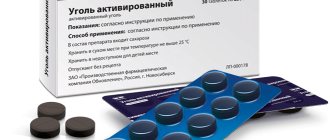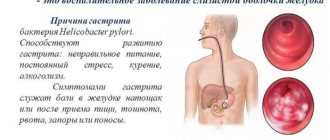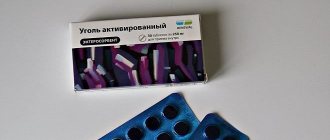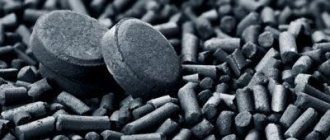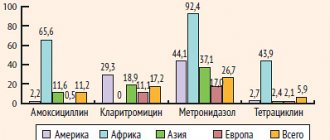- What is white coal?
- Indications for use of white coal
- Contraindications to the use of white coal
- Subtleties of receiving white coal
| When talking about enterosorbents, which help with poisoning and intoxication, the first thing that comes to mind is activated carbon. Tablets, known since childhood, are pressed powder from activated carbon. |
It has excellent sorption properties, but there is a new generation drug that surpasses activated carbon in all its therapeutic capabilities. The use of white coal today is becoming more and more popular, increasingly replacing the classic recipe for poisoning - 1 tablet of active carbon per 10 kg of weight.
What does it consist of and how does it work?
The component composition of the medicine is presented:
- amorphous silicon dioxide;
- MCC;
- D-glucose;
- food additive E 468;
- talc;
- stearic acid.
White coal is an enterosorbent that has a positive effect on the functionality of the gastrointestinal tract. The medicine reduces the level of intoxication in cases of poisoning, gastrointestinal diseases, and allergies.
Silicon dioxide captures and evacuates:
- toxic substances – waste products of pathogenic microflora, irritants of bacterial and food origin, chemical elements;
- protein residues in the intestinal tract;
- excess volume of digestive juice, gases from the intestines.
The element activates the transport of toxins from the blood and lymph into the gastrointestinal tract and their further removal. The list of substances subject to removal is presented:
- glycosides;
- plant nitrogen-containing groups, phosphorus and chlorine formations;
- driving barbituric acid, products of ethanol metabolism;
- serotonin, histamine, prostaglandin - ingredients associated with allergic and inflammatory reactions;
- carbonic acid diamide, nitrogen-containing compounds, creatinine, lipids.
Due to silicon dioxide, there is a decrease in metabolic loads on the liver and kidneys. The element helps in adjusting metabolism, improving lipid metabolism and increasing the efficiency of the immune system.
MCC refers to dietary fiber formed from plant fiber. With its help, all harmful substances are removed from the body, the state of the digestive tract is normalized, and intestinal peristalsis is stabilized.
What is white coal?
The name alone causes some dissonance. How can coal be white? This is how far pharmaceutical progress has come!
In fact, the main active ingredient in the white tablets or powder suspension is highly dispersed silicon dioxide. Along with it, microcrystalline cellulose participates in the detoxification of the body, and potato starch and powdered sugar act as auxiliary substances. As a result, the fourth generation enterosorbent comes into force, which is actively used for the prevention and treatment of poisoning and intoxication. The balanced composition of relatively simple components allows you to effectively remove pathogenic microorganisms, toxins and other harmful substances from the body.
Silicon dioxide is the basis of white coal. the use of white coal achieve thanks to this component? The following therapeutic effect is triggered:
- elimination from the body
- chemical and microbial toxins,
- bacterial and food allergens,
- protein breakdown products,
- excess intestinal gases and gastric juice;
- glycosides,
- alkaloids,
- organophosphorus compounds,
- ethyl alcohol,
- barbiturates,
- salts of heavy metals,
- serotonin,
- prostaglandin,
- histamine,
- residual nitrogen,
- creatinine,
- urea,
- lipids;
Microcrystalline cellulose complements the healing properties of silicon dioxide. This substance is produced from plant fiber, which means it has a positive effect on the functioning of the digestive tract and improves intestinal motility. In terms of its characteristics, microcrystalline cellulose is almost identical to the natural cellulose found in food products. Its main difference is its inability to break down and dissolve in the intestines. But it produces an adsorbing effect - it collects free radicals, breakdown products, and toxins on its surface for their subsequent removal. In the small intestine, thanks to microcrystalline cellulose, parietal digestion is improved, beneficial substances from vegetables and fruits, medicines and vitamins are more fully absorbed and absorbed. In addition to the above functions, cellulose irritates the intestinal receptors, which stimulates its contractions. As a result, stagnation of the food bolus is eliminated.
The sorption activity of white coal is characterized by a number of characteristics:
- the particles are distinguished by their smallest size (much smaller than activated carbon), which means the sorption area increases - up to 400 m2/g;
- the same small size of sorbent particles allows the absorption of large molecules of substances that poison the body - toxins, harmful microorganisms, products of protein breakdown in the intestines, products of incomplete metabolism;
- 1 gram of white coal absorbs up to 10 billion microbial units;
- white coal does not absorb water molecules, due to which the likelihood of developing constipation is reduced of use of white coal
- the use of white coal does not deprive the body of useful substances, coal does not absorb vitamins and microelements, macronutrients, but only the breakdown products of fat proteins, toxins of other origin (both endotoxins and exotoxins).
For whom it is intended and for whom it is prohibited
The drug is used as a dietary supplement to food, a source of plant fiber. As a sorbent, White Coal is used for patients:
- with intoxication;
- dyspeptic disorders;
- dysbacteriosis, hepatitis;
- insufficient functionality of the kidneys and liver.
The medicine is contraindicated in patients:
- with individual intolerance to its components;
- gastrointestinal ulcer in the acute phase;
- bleeding of the gastrointestinal tract;
- intestinal obstruction.
The tablets are not used for minors under 14 years of age, pregnant or lactating women.
Indications for use of white coal
All indications for the use of white coal can be combined into a general category - poisoning and intoxication. At the same time, these conditions can develop for various reasons and against the background of various diseases:
- deterioration of the gastrointestinal tract,
- acute infectious diseases,
- food poisoning of various origins (including alcohol and mushroom poisoning), helminthiases,
- hepatitis,
- stomach disorders,
- liver and kidney failure,
- allergy,
- dysbacteriosis,
- dermatitis of endogenous intoxication.
Few people know that the use of white charcoal is the way to normalize the condition of the skin. After all, many skin rashes are a reflection of internal intoxication and disturbances in intestinal function. White coal improves the functioning of the gastrointestinal tract, and as a result leads to the elimination of acne. Cleansing the intestines using white charcoal alone will not be enough for a long-term effect, and therefore the use of white charcoal will certainly be appropriate to combine with proper nutrition. The most effective use of white coal will be to eliminate acne in the forehead and chin, because they most often indicate problems in the intestines.
The use of white coal for weight loss deserves special attention. This is a popular practice that is virtually free of the disadvantages of other weight loss methods. The use of white coal should coincide with fasting days. The technique consists of drinking several white charcoal tablets at night, and the next day drinking a lot of water, fruit drinks, and unsweetened teas. During the day, a portion of chicken broth is allowed, and in the evening, a portion of low-fat cottage cheese. Several such fasting days per week allow you to achieve stunning weight loss results.
Side effect
Therapeutic procedures sometimes lead to non-standard responses of the body. The pathological condition is characterized by allergy symptoms:
- with hyperemia of certain areas of the skin;
- dermatological rashes;
- swelling, puffiness;
- obsessive itching.
The occurrence of these clinical signs requires discontinuation of the medication and additional consultation with a local doctor. The doctor will change the course scheme and clarify the new admission rules.
Manufacturer's instructions
The annotation states that White Coal is not a full-fledged medicine, but is included in a subgroup of biologically active food additives. Before starting manipulations, consultation with a gastroenterologist is necessary.
Combining tablets with other medications may cause a decrease in their overall effectiveness. If it is necessary to use other pills, the patient should inform the gastroenterologist in advance and receive a detailed explanation of further actions.
Self-medication, use in any trimester of gestation or during breastfeeding is prohibited. Sufficient clinical trials on the safety of components for the embryo and maternal body have not been conducted; the results of using coal cannot be predicted.
Preparing for an abdominal ultrasound
Abdominal ultrasound is an effective and comfortable method of obtaining data on the condition of internal organs. Its informativeness is largely due to proper preparation. If the recommendations are not followed, the clinical picture will be inaccurate or erroneous. Ultrasound makes it possible to examine parenchymal or fluid-filled organs:
- liver, spleen,
- bile ducts, gallbladder,
- pancreas,
- if necessary, organs of the retroperitoneum (kidneys, adrenal glands) and pelvis. This examination is considered separate, but is often combined with an ultrasound scan of the abdominal cavity.
Using the method, the doctor assesses the size of organs, their integrity, shape, location and quantity.
The study also allows you to detect neoplasms. Previously, during the procedure, the condition of the intestines was also studied. But it is almost impossible to do this reliably due to active peristalsis. Now the gastrointestinal tract is examined using FGDS, colonoscopy, irrigoscopy, sigmoidoscopy and other methods; ultrasound is practically not used.
However, the doctor may prescribe, for example, an ultrasound of the stomach if the patient has contraindications to gastroscopy or he categorically refuses such a study. Since this organ is hollow, technically an ultrasound will be less informative than other diagnostic methods. It will allow you to see only the walls, large tumors, cysts, gastroptosis (prolapse of the stomach).
Is it necessary to prepare
Ultrasound examination is based on the characteristics of the reflection of ultrasound waves from tissues. The device produces high-frequency oscillations, the sensor records the echo reflected from the organs and sends information to the converter. It is then displayed in real time on a monitor screen, usually in two or three dimensions.
General preparation rules
Preparation for an abdominal ultrasound begins 1 day before the procedure.
The purpose of this is to minimize the level of gas formation and provide the best visibility during manipulation. The day before an ultrasound scan, you cannot undergo gastrointestinal examinations using an X-ray machine using a contrast agent. Fibrogastroscopy is performed before or after ultrasound, with an interval of at least 24 hours. During preparation, you need to eat fractionally and on a slag-free diet. It is necessary to cleanse the intestines in advance. During an ultrasound, the abdominal organs must be free, so the examination is carried out on an empty stomach. You will have to stop eating 8, or preferably 12, hours before the procedure. Smoking and sucking lollipops are prohibited for 2 hours. If the test is scheduled after 16:00, you can have a light breakfast before 8:00.
Cleansing the intestines
Gas bubbles in the intestines make ultrasound of the abdominal cavity less informative, so preparation of the gastrointestinal tract begins 3 days in advance:
- taking carminative drugs - “Espumizan” for adults, “Bobotik” for children;
- if you suffer from constipation, you will need a cleansing enema or taking laxative medications according to the instructions (Prelaxan, Fortrans, Senadexin, Duphalac, Normaze) the evening before the study.
Previously, doctors recommended drinking activated charcoal before the procedure instead of carminatives, but modern drugs remove gases better. And if you follow a diet, the absorbent properties of coal will not be required during preparation.
Diet before ultrasound
Also, 2-3 days before the ultrasound, you need to review your diet. Proper nutrition will remove excess gas and prevent its recurrence.
Prohibited Products
The following should be excluded from the menu:
- yeast baked goods,
- raw vegetables and fruits,
- fried and spicy foods,
- fatty meats,
- milk,
- legumes - beans, lentils, peas,
- candies, sugar, cakes,
- sweeteners,
- juices, carbonated drinks, alcohol,
- coffee and tonic cocktails (energy drinks).
Before the study, you should not use chewing gum, as it contains sorbitol, which enhances intestinal motility. It is also recommended to avoid refreshing oral sprays - they also contain sorbitol.
Authorized Products
The list of prohibited foods before the examination seems so long that it is unclear what the patient should eat. Therefore, we offer a list of recommended products:
- hard-boiled eggs
- boiled, baked or steamed foods,
- lean pork, beef, lean poultry and fish,
- porridge with water from buckwheat, pearl barley, oatmeal,
- soups with vegetable or rich meat broth,
- baked fruits,
- low-fat cheese.
Portions should be reduced to the size of a fist, and food should be taken once every 4 hours. An adult should drink at least 1.5 liters of water per day.
What medications are prohibited before an ultrasound?
3 days before an abdominal ultrasound, you must give up not only some foods, but also medications, which must be agreed with your doctor.
Some medications can have a particularly strong effect on the results of the study. These include:
- "Spazmalgon"
- "Drotaverine", "No-shpa",
- "Papazol", "Dibazol".
These antispasmodics relax the intestinal muscles, impairing motility, making it difficult to visualize the abdominal organs.
Preparing for ultrasound of patients with special needs
With diabetes
Due to the nature of the disease, it is difficult for people with diabetes to follow the diet necessary to prepare for an ultrasound scan. If you do not have a snack for a long time, the condition will sharply worsen, so such patients are allowed a light breakfast 3-4 hours before the examination. This could be a couple of white crackers and unsweetened tea. For the same reason, it is advisable that ultrasound of the abdominal organs be performed in the morning.
Children
Not all children are ready to endure an 8-hour fast; for them, preparation for an ultrasound of the abdominal organs is easier:
- For infants, the study is carried out before meals (at least 3 hours must pass from the latter);
- Children under 15 years of age must wait at least 4 hours before the procedure.
In some cases, you can give children a couple of sips of water before the test, alternatively, wipe their lips with a damp cloth or ask them to rinse their mouth and spit out the liquid. But it is still better to perform an ultrasound of the abdominal cavity on an empty stomach.
Pregnant women
Metabolic processes in pregnant women are accelerated, so before the ultrasound they are allowed to reduce the period of fasting to 4-6 hours. This is especially true for women with multiple pregnancies.
Preparing for an Extended Study
If necessary, ultrasound of the abdominal organs can be supplemented with examination of the reproductive system in women and men - the uterus, ovaries, fallopian tubes, prostate, as well as the excretory system - bladder, kidneys, adrenal glands.
In this case, there are no requirements for cleansing the intestines; the preparation is different.
Preparation for examination of the reproductive system
An abdominal examination (that is, a traditional one, when the sensor does not penetrate inside the body) of the pelvic organs can only be performed through fluid in the urinary or amniotic bladder. For pregnant women, the procedure is carried out without preparation; for others, it needs to be filled - drink 1–1.5 liters of water an hour before the start.
Preparing for a kidney and bladder study
Preparing for an ultrasound scan of the excretory system also implies a full bladder - in the same way.
Then the sonologist will see the clear outlines of the organs and their structure. Otherwise, the bladder is poorly visualized, since it is a hollow organ. If you have high blood pressure or frequent cramps, your bladder should be filled naturally on the day of the test - by accumulating urine throughout the day. It is undesirable for such patients to drink a lot of water, as this can provoke an attack of convulsions or a hypertensive crisis.
Preparation for studying the biliary system
For biliary tract ultrasound evaluation, bring a snack with you to stimulate bile production before the examination. Ripe banana, natural dark chocolate, sweet tea are recommended.
How is an abdominal ultrasound performed?
The abdominal examination is performed with the patient lying on his back. Usually the procedure takes up to 20 minutes, less often up to an hour, and includes several stages:
- A colorless hypoallergenic gel is applied to the specified areas;
- an ultrasound sensor is used to study organs from the abdomen;
- the patient is asked to turn on his side;
- study organs while holding the breath or exhaling, thus changing the position of the diaphragm;
- If a kidney ultrasound is being done, after the initial scan you will be asked to empty your bladder and will be examined again after 20-30 minutes. This is necessary to assess the condition of the pyelocaliceal system;
- fill out the protocol;
- issue a conclusion.
The results of an abdominal ultrasound scan are transmitted in real time to the monitor.
The sonologist takes measurements of organs and structures, and the notes are included in the study protocol. Comparing the obtained indicators with normal ones, the specialist writes a conclusion. However, an accurate diagnosis is always within the competence of your attending physician. Ultrasound machines in medical settings can record video results onto electronic media, in 3D or 4D format. This is the most informative way to record abdominal examination data. A simple single image, which is usually taken during an ultrasound, is not able to convey the real characteristics of the organs.
What happens if you don't prepare?
Ignoring the preparation rules will lead to distorted results. Possible consequences:
- misdiagnosis;
- omission of important information (for example, about the presence of a tumor);
- the need to undergo the procedure again;
- wasting time when the disease is easy to cure.
Where to get an abdominal ultrasound
A multidisciplinary medical center invites you to undergo an abdominal ultrasound from specialists with extensive practical experience.
You'll get:
- research with accurate results, because modern powerful ultrasound scanners are used, and doctors are regularly trained and know the latest diagnostic principles;
- reasonable prices that respect your budget;
- reception from 8:00 to 20:00, including on weekends, which eliminates the need to take time off from work and report health problems;
- no queues, which saves your time;
- the atmosphere of the SPA salon - TV, soft chairs in the waiting area, friendly staff - for complete relaxation and comfortable research.
To make an appointment for an abdominal ultrasound, call us from any city by phone (long-distance toll-free line) or write to Viber, WhatsApp.
Analogs
Replacement therapy is used when symptoms of intolerance to the main drug appear. The list of popular analogues of White coal is presented:
- Carbolene;
- Carbactin;
- Carbolong;
- Carbopect;
- Microsorbom-P;
- Ultra-adsorb;
- Sorbex;
- Activated carbon.
The choice of a suitable substitute is the responsibility of the attending physician. The specialist is based on the results of a laboratory diagnostic examination, an assessment of the general condition, and the reasons for the development of allergies.
Contraindications to the use of white coal
The use of white coal produces an excellent therapeutic effect, but this does not mean that everyone can use the drug. In some cases, it is better to abandon this medication in favor of alternative drugs, or at least discuss the prospect of use with your doctor.
Conditions unfavorable for the use of white coal include:
- individual sensitivity to sorbent components,
- period of pregnancy and lactation,
- early childhood,
- peptic ulcer of the stomach and duodenum,
- intestinal bleeding,
- intestinal obstruction.
Persons diagnosed with diabetes should take into account that one tablet of white charcoal contains 0.26 grams of sucrose.
Storage and sale
You can buy the medicine at any of the available pharmacies without presenting a prescription from a doctor. The average price per package starts from 170 rubles, the final cost depends on the number of tablets, the region of residence of the patient, and trade margins of the selling company.
The medicine is stored in dark, dry rooms at temperatures up to 25 degrees. It must be securely hidden from pets and children.
The product is good for 3 years; after the expiration date stated on the box, it is disposed of together with household waste. It is strictly prohibited to take expired pills due to the risk of poisoning and the formation of complications of the current pathological process.
